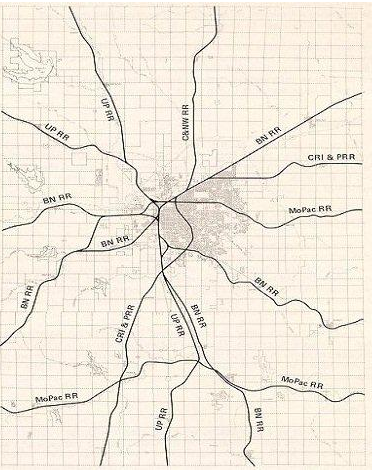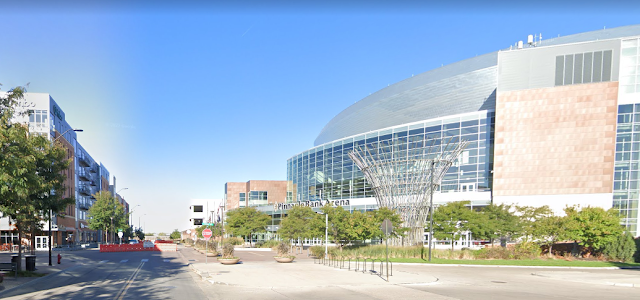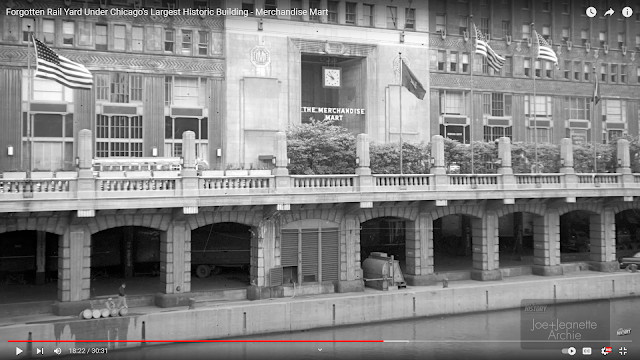Most people know the Merchandise Mart as the worlds largest building when it was opened on May 5, 1930 (
mmart). But it must have opened before it was completed because
Marchitecture states "At the time of completion in 1931, the Mart was the largest building in the world at four million square feet." It remained the largest building until 1941 when the Pentagon dethroned it. (
ViewOnCities)
 |
Facebook
Resolution |
Note that you can see
the Kinzie Street RR bridge in the down position in the center of the photo just to the right of the cold storage building.
I know of it as the building that displaced the
C&NW Wells Street passenger station. To get the two blocks it needed in a downtown location, it was erected on the air-rights of the C&NW railroad yards. As a side effect, it help beautify the river front by hiding the rail yards. (mmart) The bridge to this station was a bottleneck, so C&NW wanted to build a new station west of the river anyhow. So leasing the air-rights was a win-win.
 |
| Monique Kielar Lyle posted, 1928 |
My motivation for writing this posting now is that I came across some construction photos
 |
Jeff Nichols posted, August 1930
Aerial photo of the Merch Mart, August 1930.
Source: Detroit News Photo Collection,
Wayne State University. |
The 1931 date for completion must be wrong, because it looks done in this August, 1930 photo. But the thing that caught my eye is that you can see how the land is still industrial west of the building and how the tracks go under the road and building.
The Kinzie Street RR bridge is on the left by the cold storage building.
Evidently each Christmas Season they used to light it up with additional lights because I came across these photos for
1953 (note the tree in the middle),
1954 (note the Lindbergh light on the old Palmolive building), and
1967 (note the religion neutral "PEACE ON EARTH").
Update:
 |
Eric Dudi Huebner posted
Merchandise Mart Roof
Flying Carpet promotion for floor covering show.
1957 |
 |
Mike Tuggle posted
Wolf Point and Merchandise Mart in 1954.
[Note the coating of black from coal soot. It was still white in the above 1930 photo. In the 1949 photo at the top, you can also see the lower stories are darker than the upper stories.] |
 |
MWRD posted from:
Linda Connelly posted
1928. "Site of the Merchandise Mart" |
 |
| Cindy Anthony Drabing shared, 1929 |
 |
Raymond Kunst posted from an album
Sharon Avendano shared a David M Laz post
Merchandise Mart under construction as of December 30, 1929. The exterior did not stay clean for long!
Eileen Priest Worked there in the 1990's and had assigned parking in the 2nd lower level of the underground parking area. Massive support columns were evenly spaced throughout the entire "floor". There'd be a column, then 2 parking spaces, another column and another 2 parking spaces, and so on. The columns ate into the striped space set apart for the car so parking could be tricky if the person in the space next to you parked weird.
Leonard Lelko Largest building in the world at one time . Pertaining to floor space .
Pierre Hamon shared
Linda Connelly posted
The Merchandise Mart under construction, seen from the Lake Street Bridge in 1929. Chicago Tribune Archives.
Garry Buzard Wasn't the Merch Mart the largest office building in the USA until the Pentagon was built?
Michael Durkin The Merchandise Mart has 4 million square feet of floor space while the Pentagon has 6.5 million square feet.
Ana Guera Built in 1930 by Graham, Anderson, Probst, and White. For Marshall Field. It was supposed to be a wearhouse for his department stores, but it was built around the great depression. Sold it in 1945 to Joseph Kennedy for 17 million, 13 million than the original cost. In 1998 the Kennedy's sold it for over 450 million. 2nd largest building in America in floor space. For many years carried its own zip code. (60654)
Ronald Wiggin When I worked there in 1969, I found out that all the radio studios had been torn out replaced by giant color TV studios. Sorry I missed the radio period. I heard that Amos and Andy came out of Chicago. Also due to Chicago being about the center of the country and the broadcasts being on copper cables wrapped to about 8 inches round before the insulation casing, those cables spread out from that point to all over the country like a spider web broadcasting from Chicago. Lots of radio personalities lived in Chicago. Not to mention that due to radio being so big in Chicago, the advertising agencies were major there, more than NYC, and is still there. |
 |
FP Martinez posted
[Years of coal soot.] |
This video has a lot of information about the Mart. I highlight the part about the C&NW freight yard that was under the building.
A 1930 view of the river side. What amazes me is how low the buildings were so that you could get a clear shot of the river side from so far away.

























































